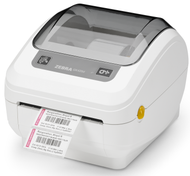What You Need to Know about Thermal Transfer vs Direct Thermal Label Printers
Posted by Jim on 10th Jul 2020
Thermal transfer printing may seem like a basic choice for printing barcodes and labels. These printers use thermal printing technology to print black-only text and graphics on white or colored thermal label media. They tend to have a lower print resolution than their full color inkjet counterparts and are a good, economical choice for printing no-frills labels like shipping labels, barcodes, and inventory tags. That said, there’s more to thermal label printing than meets the eye, making it important to understand the nuances of this type of label printing technology.
Thermal Transfer vs Direct Thermal Label Printers
The first consideration has to do with choosing either a thermal transfer or direct thermal label printer — or one that can print in both modes. What’s the difference? Both use heat, but thermal transfer label printers require the use of an ink-coated thermal transfer ribbon while direct thermal label printers do not. Instead, direct thermal label printers must use special direct thermal labels which contain embedded dyes that appear when heated by the thermal printhead.
Print Quality Differences
The print quality of thermal transfer tends to be better than that of direct thermal label printers, though there are other factors at play including the printer’s print resolution as well as the intended application. That’s because direct thermal labels tend to fade over time and are intended for short-term applications like shipping labels and food service labels.
In addition, there are three categories of thermal transfer ribbons available for thermal transfer label printers, each with unique characteristics that affect print quality and label durability:
-Wax ribbons — Wax ribbons contain a wax-based ink, which is extremely affordable and good for general purpose label printing applications. Thermal transfer label printers produce darker text and graphics than direct thermal label printers.
-Wax-resin ribbons — Adding resin to the formula produces a more durable print than wax alone, making wax-resin ribbons a good choice for applications that need greater durability.
-Resin ribbons — Resin ribbons are used for the most durable label applications such as GHS BS5609 and chemical labels.
Both types of thermal label printers are available with varying print resolutions. Where color label printers often come with print resolutions in the 1200 to 4800 dpi range, thermal label printers typically have lower print resolutions such as in the 200 to 600 dpi range. These lower print resolutions tend to be fine for the industrial applications that are typically served by thermal label printers.
Other Considerations
Like other categories of printers, thermal label printers are available in mobile, desktop, and industrial models. Portable, mobile thermal label printers are ideal for mobile workers like field technicians and restaurant servers whereas desktop models are typically used by office and warehouse personnel. Industrial models, which are often configured as a fleet of label printers, tend to be larger, more rugged, able to print larger 8-inch labels and barcodes, and loaded with features and remote management tools.
OptiMedia Labs has a large selection of thermal label printers designed for a wide range of applications along with all of the supplies and accessories you need. If you need help, let us know and we’ll be happy to point you in the right direction.


